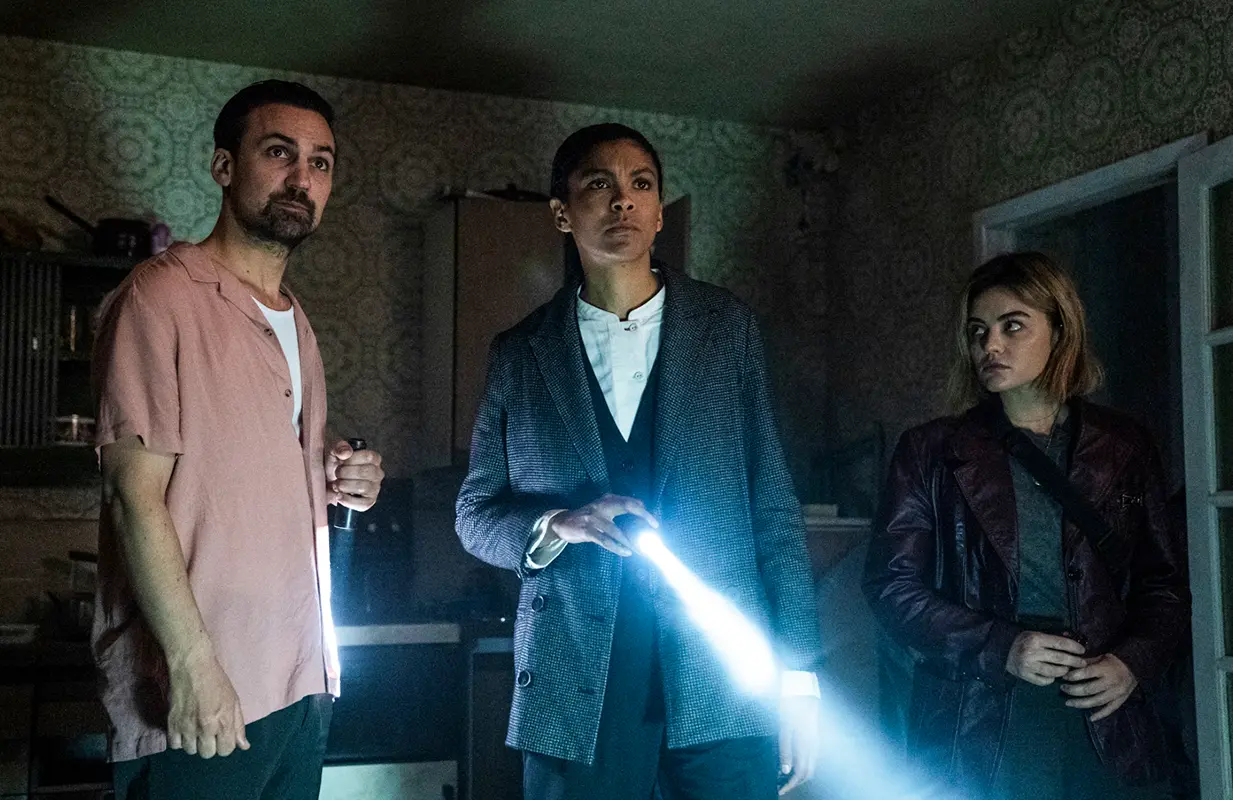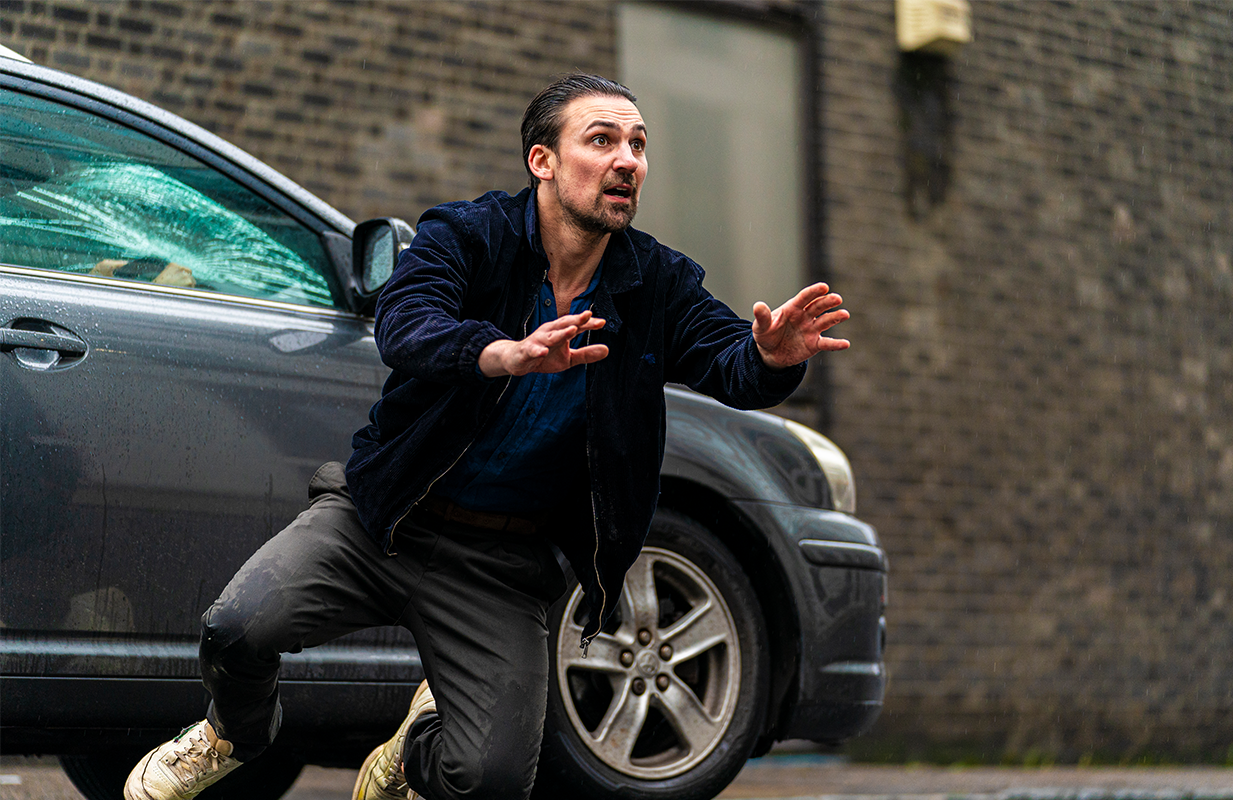Ragdoll Will Fill the Mare of Easttown-Sized Hole in Your Heart
-
 Three detectives (Henry Lloyd-Hughes, Thalissa Teixeira, and Lucy Hale) are tasked with investigating a series of gruesome murders in Ragdoll. (Photo: AMC+)
Three detectives (Henry Lloyd-Hughes, Thalissa Teixeira, and Lucy Hale) are tasked with investigating a series of gruesome murders in Ragdoll. (Photo: AMC+)Detective stories may be a dime a dozen on television, but few have dominated the conversation quite like Mare of Easttown, Kate Winslet’s Emmy-winning ode to Delaware County, Pennsylvania. The HBO drama used the tried-and-true crime drama formula — a shocking murder, a detective with emotional baggage, a community consumed by fear — as the foundation to tell a larger story about abuse, addiction, sacrifice, and modern-day policing, and in the process, set a new standard for police dramas.
AMC+ drama Ragdoll, though not quite as affecting as Mare of Easttown, comes close to reaching the bar set by its predecessor earlier this year. Both series explore the lingering effects of trauma and mental illness within a gripping murder mystery. Ragdoll is packed with gruesome scenes that pull the rug out from under the audience’s feet, all but ensuring that viewers will stick around for the next episode.
Executive produced by the team behind Killing Eve, the London-set Ragdoll follows three detectives tasked with investigating the murder of six people who have been dismembered and sewn together into the shape of one grotesque body, nicknamed the “Ragdoll.” While newly reinstated detective sergeant Nathan Rose (Henry Lloyd-Hughes) and his boss, detective inspector Emily Baxter (Thalissa Teixeira), were partners before Rose’s suspension, they now find themselves joined by detective constable Lake Edmunds (Lucy Hale), the unit’s new, American recruit. Edmunds’ no-nonsense attitude clashes with Rose’s barely-controlled chaos, but they're forced to put their differences aside when the case takes a turn: the ‘Ragdoll Killer’ sends the police a list of his next six victims, and it includes Rose’s name at the very end. As Rose, Baxter, and Edmunds set out to protect those on the list, they come face-to-face with a monstrously imaginative serial killer who manages to stay one step ahead at every turn.
When Rose first sees the Ragdoll, it opens the wound that led to his suspension two years prior. Ragdoll’s first episode begins with a flashback to this controversy, which we learn involved Rose mishandling evidence in his investigation of the so-called ‘Cremation Killer,’ an error that resulted in the killer going free. Needless to say, this experience weighs heavily on Rose, and although he’s been reinstated to the Greater London Police force (with a demotion from detective inspector to detective sergeant) he struggles to cope with his trauma and grief. Things only get worse when the team learns that the Ragdoll and Cremation Killer cases are connected, a discovery that prompts Rose to begin his own investigation, much to his coworkers’ chagrin.

Rose’s storyline is compelling — and Lloyd-Hughes does a good job of portraying the detective’s shifty nature — but it takes a long time for Ragdoll to explain all of this to viewers. The opening flashback moves so quickly that it’s difficult to understand what’s happening (newspaper headlines attempt to provide context, but the print is so small and they appear on-screen so briefly that they’re ineffective without repeatedly pausing and rewinding). Afterwards, the show immediately moves into the Ragdoll case, and viewers are forced to rely on a single conversation between Baxter and Edmunds to fill in the blanks. A few additional flashbacks help things come together by the end of the premiere, but the initial jump is disorienting. I’m all for trusting the viewer, but when scenes from the past and present are so intimately connected, it’s helpful to offer a bit of context about what's happened in the interim.
That Ragdoll is able to overcome its clunky premiere is largely thanks to its extreme theatricality. Not for the faint of heart, the AMC+ drama features multiple deaths every episode, each more elaborate and horrific than the last. Just as it’s impressive to watch the Ragdoll Killer continue to outsmart the detectives, it’s easy to admire the writers’ ability to craft such a captivating narrative, both within each episode and across the entire season. It’s here that the series’ Killing Eve connection becomes most clear, as both series deftly outsmart their audiences with mind-boggling twists.
The crime drama also boasts a particularly strong performance from Lucy Hale. Back in March, Hale was the first star cast in the series, leading many to believe that Ragdoll would be the Lucy Hale show. It’s not — the drama is very much about the three detectives, as a unit — but Hale is excellent as an idealistic young officer who believes she can change policing from within (Baxter, Rose, and their bosses happily laugh her off as she rants about inequity and state-sanctioned violence). The actress has said that she sees Ragdoll “not even as a new chapter, but as a new book” in her career, and she’s absolutely right: as DC Edmunds, she’s able to stretch her wings and inhabit a much darker, more socially-conscious persona than she did in Pretty Little Liars or Katy Keene. With this nimble performance now on her resume, it'll be interesting to see what Hale does next, and whether she’ll have to “fight” quite so hard to land more adult roles in the future.
Like Mare of Easttown, which wrapped its run in just seven episodes, the six-part Ragdoll has the burden of telling a rapidly-intensifying story in a limited amount of time, but once the groundwork is set, it becomes impossible to disengage from its spiraling story. Viewers able to stomach the gore are in for a wild ride of psychological puzzles and macabre murders that will leave them haunted long after the final credits roll.
Ragdoll premieres Thursday, November 11 on AMC+. New episodes drop Thursdays through December.
Claire Spellberg Lustig is the Senior Editor at Primetimer and a scholar of The View. Follow her on Twitter at @c_spellberg.
TOPICS: Ragdoll, Mare of Easttown, Henry Lloyd-Hughes, Lucy Hale, Thalissa Teixeira, Crime
- TV Today: The ACM Awards Hop to Streaming and The Bachelor's Women Tell All
- TV Today: Better Things Begins Its Final Season, The Good Doctor Makes an Early Comeback
- Lucy Hale's AMC+ thriller Ragdoll struggles to mix British humor with a true-crime thriller
- Lucy Hale says she had to "fight" to play an American detective in Britain on the hunt for a serial killer in AMC+'s Ragdoll